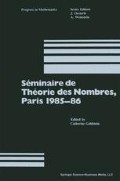Résumé
Le théorème d’irréuctibilité de Hilbert est un réltat de la fin du sièle dernier [17]. Le problème est le suivant: étant donnés un corps k et Pl ,…, Pn n polynômes irréductibles dans k(X1,..., Xr)[Y1 ,..., Ys] , montrer que l’ensemble qu’on note classiquement Hk(P1 ,..., Pn), constitué des spécialisations (xl , x2 ,..., xr) des indéterminées (X1 ,..., Xr) pour lesquelles les polynômes Pi(xl ,..., xr , Y1 ,..., Ys), i= 1,2 ,..., n, sont irréductibles dans k[Y1 ,..., Ys], contient beaucoup d’éléments de kr. Précisément, on appelle partie hilbertienne de kr tout ensemble, intersection d’un ensemble du type Hk(P1 ,..., Pn) avec un ouvert de Zariski de kr et on dit que le corps k est hilbertien si pour tout entier r≥1, les parties hilbertiennes sont non vides. On appelle aussi ensemble mince tout ensemble dont le complémentaire contient une partie hilbertienne. En ces termes, le théorème d’irréductibilité de Hilbert s’énonce:
Thèorème 0 — Le corps Q des nombres rationnels est un corps hilbertien.
Access this chapter
Tax calculation will be finalised at checkout
Purchases are for personal use only
Preview
Unable to display preview. Download preview PDF.
Bibliography
E. Bombieri.- On G-functions, Recent progress in analytic number theory H. Halberstam and C. Hooley ed., Acad. Press (1981), vol. 2, 1–67.
E. Bombieri.- On Weil’s “Théorème de Décomposition”, Amer. J. Math., 105 (1983), 295–308.
P. Bundschuh.- Une nouvelle application de la méthode de Gel’fond. Sem. Delange-Pisot-Poitou, Théorie des Nombres, 19ème année (1977–78), N0 42.
D.V. and G.V. Chudnovsky.- Applications of Padé approximations to diophantine inequalities in values of G-functions, Number Theory, Sem. N.Y., 1983–84, Lect. Notes Math. 1135, (1985), 9–51.
S.D. Cohen.- The distribution of the Galois groups of integral polynomials, Illinois J. Math. (1979), Vol. 23, N0 1 135–152.
P. Débes.- Une version effective du théorème d’irréductibilité de Hilbert, Sém. Anal; Ultramétrique, Amice-Christol-Robba, 10ème année (1982–83), N0 10.
P. Dèbes.- Spécialisations de polynômes, Math. rep. Acad. 0 Sc., Royal Soc. Canada, Vol. V, n 6, (Dec. 1983).
P. Dèbes.- Valeurs algébriques de fonctions algébriques et théorème d’irréductibilité de Hilbert, Thèse Sème cycle, Univ. P. et M. Curie (Paris V I ), (1984).
P. Débes.- Quelques remarques sur un article de Bombieri concernant le théorème de décomposition de Weil, Amer. J. Math. 107 (1985), 39–44.
P. Dèbes.- G-fonctions et théorème d’irréductibilité de Hilbert, Acta Arithmetica, Vol. 47, N0 4, (à paraître).
P. Dèbes.- Parties hilbertiennes et progressions géométriques, C.R. Acad. Sc. Paris, t. 302, Série I, no 3, (1986).
R. Dvornicich and U. Zannier.- Fields containing values of algebraic functions, Publ. Univ. Pisa (Novembre 1983 ).
M. Fried.- On Hilbert’s irreducibility theorem, J. Number Theory, 6 (1974), 211–231.
M. Fried.- Constructions arising from Neron’s high rank 0 curves, Trans. Amer. Math. Soc. Vol. 281, N 2, 1984.
M. Fried.- On the Sprindzuk-Weissauer approach to universal Hilbert subsets, Israel. J. Math. vol. 51, No 4, 1985.
A.L. Galochkin.- Lower bounds of polynomials in the values of a certain class of analytic functions, Math. Sb. 95 (1974), 396–417.
D. Hilbert.- Uber die Irreduzibilität ganzer rationaler Funktionen mit ganzahligen Koeffizienten, Gesammelte Afhandlungen, Springer-Verlag (1983) [réimpression Chelsea (1965)] Vol. 2, No 18, 264–286. Ou J. für die reine und angew. Math. 110 (1982), 104–129.
J.C. Lagarias, H.L. Montgomery and A.M. Odlyzko.- The bound for the least prime ideal in the Chebotarev density theorem, Invent. Math. 54 (1979), 271–296.
S. Lang.- Fundamentals of Diophantine Geometry Springer-Verlag (1983).
]J.F. Mestre.- C.R. Acad. Sci. Paris 295 (1982), 643–644.
A. Néron.- Problèmes arithmétiques et géométriques rattachés à la notion de rang d’une courbe algébrique dans un corps, Bull. Soc. Math. France, 80 (1952), 101–166.
A. Néron.- Quasi-fonctions et hauteurs sur les variétés abéliennes, Ann. of Math. 82 (1965) no 2, 249–331.
[23]C. Runge.- Veber ganzzahlige Lösungen von Gleichungen zwischen zwei Veränderlichen, J. für die reine und angew. Math. 100 (1887), 425–435.
]A. Schinzel.- On Hilbert’s irreducibility theorem, Acta Arithmetica 16 (1965), 334–340.
T. Schneider.- Rationale Punkte Uber ciner algebraischen Kurve, Sem. Delange-Pisot-Poitou, Théorie des Nombres, 15ème année (1973/74), N0 20.
T. Schneider.- Eine bemerkung zu einem Satz von C.L. Seigel, Comm. pure and applied Math. 29 (1976), 775–782.
J.-P. Serre.- Autour du théorème de Mordell-Weil, II, Cours au Collège de France, (1980/81), Notes rédigées par M. Waldschmidt.
C.L. Siegel.- Uber Einige Anwandungen diophantischer Approximationen, Gesammelte Afhandlungen, Springer-Verlag 0 (1966), vol. 1, N 16, 209–266. Ou Abh. Preus. Akad. Wiss. Phys. Math. Kl. 1 (1929), 14–67.
V.G. Sprindzuk.- Hilbert’s irreducibility theorem and rational points on algebraic curves, Doklady Acad. Nauk. SSSR 247 (1979), 285–289.
V.G. Sprindzuk.- Reducibility of polynomials and rational points on algebraic curves Doklady Acad. Nauk. SSSR 250 (1980), 1327–1330.
V.G. Sprindzuk.- Diophantine equations involving unknown primes, Trudy M.I.A.N. SSSR 158 (1981), 180–186.
V.G. Sprindzuk.- Arithmetic specializations in polynomials, J. Reine und Angew. Math. 340 (1983), 26–52.
A. Weil.- Arithmetic on algebraic varieties, Annals of Math. 53 (1951), 412–444.
R. Weissauer.- Hilbertsche librper, Thesis, Heidelberg (1980).
Author information
Authors and Affiliations
Editor information
Editors and Affiliations
Rights and permissions
Copyright information
© 1987 Springer Science+Business Media New York
About this chapter
Cite this chapter
Debes, P. (1987). Resultats Recents Lies Au Theoreme D’Irreductibilite de Hilbert. In: Goldstein, C. (eds) Séminaire de Théorie des Nombres, Paris 1985–86. Progress in Mathematics, vol 71. Birkhäuser, Boston, MA. https://doi.org/10.1007/978-1-4757-4267-1_2
Download citation
DOI: https://doi.org/10.1007/978-1-4757-4267-1_2
Publisher Name: Birkhäuser, Boston, MA
Print ISBN: 978-1-4757-4268-8
Online ISBN: 978-1-4757-4267-1
eBook Packages: Springer Book Archive

